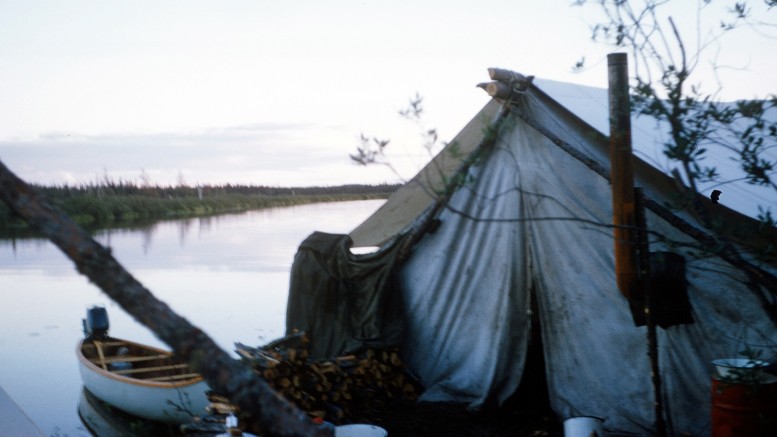Toward the end of my first summer in the bush in 1958, we had a crew change. I was party chief of a three-man McPhar Geophysics crew locating and detailing airborne electromagnetic anomalies, and a recent graduate of MIT in geology and geophysics.
We were covering the Evans Lake greenstone belt in northwestern Quebec, 60 miles north of the Mattagami greenstone belt, where there had been a recent discovery. We were camped on an unnamed river that we called Dana River, since it flowed north into Dana Lake, a complex western lobe of Evans Lake. (The river is now officially named Pauschikushish Ewiwach.)
The Dana River country was flat and mostly muskeg, so our tent was pitched in the alders right on the riverbank where the pilot had dropped us. After a few days of rain the Dana River rose 15 inches and spread under our tent, and we were able to tie our canoe to a tent pole.
Angus Wilbur, a veteran bushman, and Johnnie, a young man, had flown into the bush with me in June but had spent the summer in another McPhar camp. The plane also brought in Tom and Martin, two prospectors.
It was common to attach a couple of prospectors to a geophysical crew, but they usually operated more or less independently from an adjacent tent. The geologist would suggest areas to be prospected, but most prospectors were independent by nature and resisted direction by anyone, especially a geologist, and even more so if he was young and inexperienced.
You could suggest to a prospector that he should prospect an area north of camp, and he would usually leave camp in the morning going north. But if he had a theory that the best prospecting was south of camp, he’d probably just circle around and go where he wanted.
In the evening he might again circle the camp and return from the north, or he might just walk into camp from the south. If you were imprudent enough to question this, he could give several plausible explanations that wouldn’t satisfy you at all.

Camp on the bank of “Dana River” (now officially named Rivière Pauschikushish Ewiwach) in the Evans Lake area of northwestern Quebec during the summer of 1958. Photo by Harold Linder.
Most geologists quickly learned to leave a prospector alone. His instincts were often as good as his theories were laughable. The important thing was that he was out there breaking rocks.
After a few days, I noticed that Johnnie was probably getting “bushed.” One day he forgot his axe and had to walk quite a ways back to camp to get it. Angus had already told me that in a previous camp, Johnnie had notched numerous trees so that in a windstorm they would fall on their tent. When quizzed, Johnnie acted surprised and told Angus he was just blazing trees for the hell of it.
Then one day Angus took me aside and asked if I saw anything funny about Johnnie. He said that when he and Johnnie were together in the bush, Johnnie would laugh for no apparent reason and at first Angus thought he was missing a joke. Then Johnnie began to laugh around camp at nothing in particular. When we asked him what was funny, he’d just laugh more and say nothing. After a few days in a small tent, this got very annoying.
One rainy day Johnnie sat in the corner of the tent, and while Angus and I read, he slowly whittled all of our carrots into a pile of shavings that formed a cone about a foot high. We observed but said nothing. Later, Angus stopped Johnnie just as he was about to take a swig out of a gallon jug of Javex bleach, apparently to rinse his mouth after brushing his teeth.
Because we were leaving the bush soon, I didn’t think it necessary to order a special plane to fly him out, but we watched him very carefully and I made a point of hiding the kitchen knives. Everyone in the bush gets a little strange, if they weren’t already, but Johnnie was really bushed.
Meanwhile the two prospectors cooked in their own tent but usually came to our tent after supper to visit and to play cribbage. They were an interesting pair, I think from somewhere in northern Ontario. Tom was a tall, thin and fit man with a Scandinavian accent, probably about 65. He was stern and slow to laugh. We somehow got the idea that he’d run away to sea as a young man and had had a lot of adventures before coming to Canada. Tom’s actions were slow and deliberate, but he still seemed more fit than Martin, who was a stocky man, probably in his fifties and more outgoing.
I was curious to know more about them and how they came to work together. But the bush was a lot like the Wild West, where it wasn’t a good idea to ask too many questions. If a man wanted to tell you why he was in the bush and something about his background, he’d tell you in good time. You took people as they came and learned to work with them, always looking out for their strengths, weaknesses and quirks.
We played a three-game series of cribbage every night by candlelight, usually Tom and I as partners against Angus and Martin. After several nights, I noticed that Martin was making some stupid mistakes, and when I finally got him alone, I made some comment. Martin looked chagrined and managed a wry smile.
It seemed that Tom took the crib game very seriously. When he won, he went back to his tent whistling and happy. If he lost, he was crushed and went to bed without saying a word. Martin didn’t care about the game, so he deliberately let Tom win so he’d talk to him when they went back to the tent.
Living together in the bush meant making accommodations of many kinds. And my first summer in the bush was certainly a continuation of my education.
— Dr. Harold Linder is an exploration geologist who has worked on all seven continents and is now retired in Anthem, Arizona. He discovered the giant, unmined Schaft Creek porphyry copper-molybdenum deposit in northern B.C. in 1968 for Hecla Mining. In 1986 he discovered the Castle Mountain gold deposit in the Mojave Desert of southern California for Viceroy Resources, which produced over 1.25 million oz. gold between 1992 and 2001. The preceding is an excerpt from his new memoir, “Wild Places: The Adventures of an Exploration Geologist” which is available at amazon.com and amazon.ca.




Be the first to comment on "Odds ‘n’ Sods: Young Johnnie gets bushed"